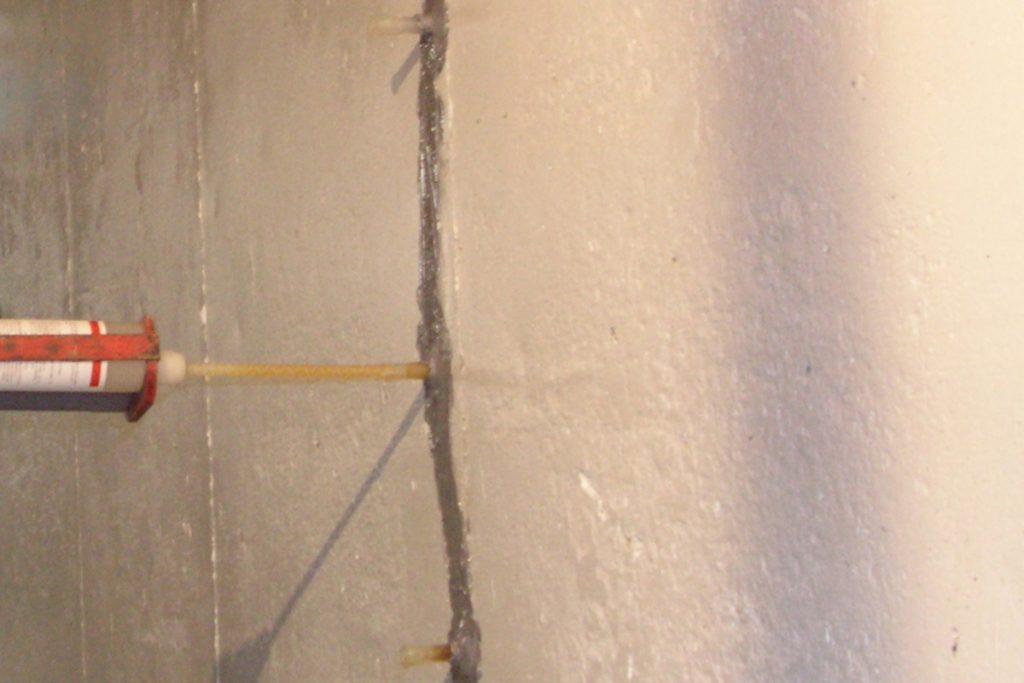Crack injection has arguably become the most common method of repairing foundation cracks over the last few decades. In this post I discuss the crack injection processes and their selection for fixing cracks in foundations and poured concrete cracks in general.
Crack Injection – In a nutshell
Crack injection is the process of forcing a fluid resin into a void in a foundation wall; in this context we are referring to a crack in the foundation or any poured concrete structure. Essentially, once the resin has cured the foundation crack no longer exists.
There are two types of resin used for injecting foundation cracks: epoxy and polyurethane (also referred to as urethane). Epoxy and polyurethane resins have different properties; consequently their use will vary depending upon the characteristics of the foundation crack to be repaired.
Crack injections are performed using either low pressure (40 psi) or high pressure (typically 1200 – 3200 psi).
Many homeowners wonder which injection method is best, epoxy crack injection or polyurethane crack injection. This question doesn’t have a clear cut answer because the resins each have properties that make them most suitable for certain applications and the pressure used can vary based on the type of resin used.
Epoxy and polyurethane resins compared
The characteristics of epoxy and polyurethane resins are radically different.
Very simply, epoxy injection resin is essentially glue that, once cured, has a bond strength exceeding the strength of concrete; this makes epoxy ideal for structural crack repair. Epoxy resin, like polyurethane, is formulated in different viscosities from very thin to quite thick. The cure time for epoxy is shorter at higher temperatures; in general, epoxy cures in 4 – 6 hours at 77° Fahrenheit. Epoxy resin does not bond to wet surfaces and is typically injected at low pressure.
Polyurethane injection resin is very different from epoxy. Polyurethane is a fluid resin that expands as it cures and has no real strength to it as epoxy does. The forceful expansive nature of polyurethane, as well as its increased reactivity in the presence of moisture and its flexibility once cured make it the resin of choice for the majority of leaking foundation crack repairs. Polyurethane injection can be done at both high and low pressures and temperature doesn’t negatively affect the curing time which is generally 5 – 20 minutes.
Injection pressure – High or Low?
Normally the average homeowner isn’t concerned about how much pressure will be used to perform their foundation crack repair. In some instances more curious clients will want to know more detail about this. In a residential setting, epoxy crack injections are always performed at low pressure. The use of low pressure for injection is of concern to some people who might think that the resin won’t fully penetrate the foundation wall if the pressure is too low. The reality is that the low pressure injection is still done at a higher pressure than the hydrostatic pressure causing water to penetrate a crack from the outside. If groundwater can penetrate a crack and enter your basement at low pressure, why can’t the epoxy travel to the outside at a higher pressure?
Like epoxy crack injection, polyurethane crack injection can also be done at low pressure. It is common for polyurethane crack injections to be done at high pressure using an electric pump. High pressures can be useful when cracks are wide and require large quantities of polyurethane. High pressure may also be required to force resin into fine/hairline cracks. It should be noted that the Province of Ontario Standard Specification OPSS 932 requires the use of high pressure for polyurethane crack injection on government construction sites.
Criteria for selecting the injection method to use
Homeowners that choose to obtain multiple quotes are naturally confused when different basement leak repair companies propose different approaches for the repair of the very same foundation crack. Here are the points that matter:
- Currently, foundation wrap (air-gap membrane, Delta-MS membrane) is being used in all new construction so resins flowing through cracks to the outside could conceivably drain out of the crack in the hours following an injection. The short cure time of polyurethane has a great advantage over epoxy as far as this material loss is concerned;
- Structural crack repair demands a strong bond; the bond strength of epoxy is stronger than that of the concrete itself.
- When cracks are actively leaking or wet / damp, epoxy will not bond; once again, polyurethane has the advantage;
- Polyurethane expands with surprisingly tremendous force, it is not uncommon to observe polyurethane oozing out of the wall outside of the area where it was injected; this filling of porous concrete is surely beneficial;
- As polyurethane reacts favourably in the presence of water it is a viable repair when a foundation crack is leaking; and finally,
- The polyurethane injection process favours the injection to less accessible cracks (for example behind a stair landing).
It should be noted that crack injection is not a crack repair method suitable for repairing cracks in concrete block foundations.
